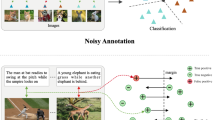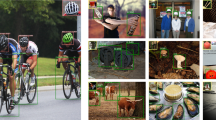Abstract
Deep hashing has been widely applied in large scale image retrieval due to its high computation efficiency and retrieval performance. Recently, training deep hashing networks with a triplet ranking loss become a common framework. However, most of the triplet ranking loss based deep hashing methods cannot obtain satisfactory retrieval performance due to their ignoring the relative similarities among the objects. In this paper, we propose a method to learn the discriminative object features and utilize these features to compute the adaptive margins of the proposed loss for learning powerful hash codes. Experimental results show that our learned hash codes can yield state-of-the-art retrieval performance on three challenging datasets




Similar content being viewed by others
References
Habimana O, Li Y, Li R et al (2020) Attentive convolutional gated recurrent network: a contextual model to sentiment analysis. Int J Mach Learn Cybern 11:2637–2651
Zhu J, Wu S, Zhu H et al (2019) Multi-center convolutional descriptor aggregation for image retrieval. Int J Mach Learn Cybern 10(7):1863–1873
Yao T, Long F, Mei T, et al (2016) Deep semantic-preserving and ranking-based hashing for image retrieval. In: International joint conference on artificial intelligence, pp 3931–3937
Lai H, Pan Y, Liu Y, et al (2015) Simultaneous feature learning and hash coding with deep neural networks. In: Computer vision and pattern recognition, pp 3270–3278
Jin X, Sun W, Jin Z (2020) A discriminative deep association learning for facial expression recognition. Int J Mach Learn Cybern 11(4):779–793
Kalantidis Y, Mellina C, Osindero S (2016) Cross-dimensional weighting for aggregated deep convolutional features. In: European conference on computer vision, pp 685–701
Xu J, Shi C, Chengzuo Q, et al (2018) Unsupervised part-based weighting aggregation of deep convolutional features for image retrieval. In: AAAI Conference on artificial intelligence, pp 7436–7443
Shen F, Shen C, Liu W, et al (2015) Supervised discrete hashing. In: Computer vision and pattern recognition, pp 37–45
Ng WWY, Jiang X, Tian X et al (2020) Incremental hashing with sample selection using dominant sets. Int J Mach Learn Cybern 11(12):2689–2702
Li S, Chen Z, Lu J, et al (2019) Neighborhood preserving hashing for scalable video retrieval. In: International conference on computer vision, pp: 8212–8221.
Li J, Ng WW, Tian X et al (2020) Weighted multi-deep ranking supervised hashing for efficient image retrieval. Int J Mach Learn Cybern 11(4):883–897
Zhang J, Peng Y (2018) Query-adaptive image retrieval by deep-weighted hashing. IEEE T Multim 20(9):2400–2414
Deng C, Yang E, Liu T et al (2019) Unsupervised semantic-preserving adversarial hashing for image search. IEEE T Image Process 28(8):4032–4044
Do T, Doan A, Cheung N (2016) Learning to hash with binary deep neural network. In: European conference on computer vision, pp 219–234
Shen F, Xu Y, Liu L et al (2018) Unsupervised deep hashing with similarity-adaptive and discrete optimization. IEEE T Pattern Anal 40(12):3034–3044
Shen Y, Liu L, Shao L (2019) Unsupervised binary representation learning with deep variational networks. Int J Comput Vision 127:1614–1628
Tian Z, Zhang H, Chen Y, et al (2020) Unsupervised hashing based on the recovery of subspace structures. Pattern Recogn. https://doi.org/10.1016/j.patcog.2020.107261
Xia R, Pan Y, Lai H, et al (2014) Supervised hashing for image retrieval via image representation learning. In: National conference on artificial intelligence, pp 2156–2162
Wang D, Gao X, Wang X et al (2016) Multimodal discriminative binary embedding for large-scale cross-modal retrieval. IEEE T Image Process 25(10):4540–4554
Xu X, Shen F, Yang Y et al (2017) Learning discriminative binary codes for large-scale cross-modal retrieval. IEEE T Image Process 26(5):2494–2507
Li W, Wang S, Kang W (2016) Feature learning based deep supervised hashing with pairwise labels. In: International joint conference on artificial intelligence, pp 1711–1717
Zhu H, Long M, Wang J, et al (2016) Deep hashing network for efficient similarity retrieval. In: National conference on artificial intelligence, pp 2415–2421
Liu H, Wang R, Shan S, Chen X (2016) Deep Supervised Hashing for Fast Image Retrieval. In: IEEE conference on computer vision and pattern recognition, pp. 2064–2072.
Junjie C, Cheung WK, Wang A (2018) Learning deep unsupervised binary codes for image retrieval. In: International joint conference on artificial intelligence, pp 613–619
Huang C, Loy CC, Tang X (2016) Unsupervised learning of discriminative attributes and visual representations. Computer vision and pattern recognition, pp 5175–5184
Deng C, Chen Z, Liu X et al (2018) Triplet-based deep hashing network for cross-modal retrieval. IEEE T Image Process 27(8):3893–3903
Dai P, Ji R, Wang H, et al (2018) Cross-modality person re-identification with generative adversarial training. In: International joint conference on artificial intelligence, pp 677–683
Min W, Mei S, Li Z et al (2020) A Two-Stage triplet network training framework for image retrieval. IEEE T Multim. https://doi.org/10.1109/TMM.2020.2974326
Norouzi M, Fleet D J, Salakhutdinov R (2012) Hamming distance metric learning. In: Neural information processing systems, pp 1061–1069
Chen W, Chen X, Zhang J, et al (2017) Beyond triplet loss: a deep quadruplet network for person re-identification. In: Computer vision and pattern recognition, pp 1320–1329
Simonyan K, Zisserman A (2014) Very deep convolutional networks for large-scale image recognition. arxiv: 1409.1556
Tolias G, Sicre R, Jegou H (2016) Particular object retrieval with integral max-pooling of CNN activations. International conference on learning representations, pp 1–12
Wei X, Luo J, Wu J et al (2017) Selective convolutional descriptor aggregation for fine-grained image retrieval. IEEE T Image Process 26(6):2868–2881
Fu Z, Robleskelly A, Zhou J (2011) Milis: multiple instance learning with instance selection. IEEE T Pattern Anal 33(5):958–977
Krizhevsky A (2009) Learning multiple layers of features from tiny images, Technical Report, Computer Science Department, University of Toronto
Chua T, Tang J, Hong R, Li H (2009) Nus-wide: a real-world web image database from national university of Singapore. In: ACM conference on image and video retrieval, pp 1–9
Netzer Y, Wang T, Coates A (2012) Reading digits in natural images with unsupervised feature learning. In: NIPS Workshop on Deep Learning and Unsupervised Feature Learning, pp 1–9
Gong Y, Lazebnik S, Gordo A et al (2013) Iterative quantization: a procrustean approach to learning binary codes for large-scale image retrieval. IEEE T Pattern Anal 35(12):2916–2929
Zha Y, Qiu Z, Zhang P et al (2020) Unsupervised ensemble hashing: boosting minimum hamming distance. IEEE Access: 42937–42947
Liu W, Wang J, Ji R, et al (2012) Supervised hashing with kernels. In: Computer vision and pattern recognition, pp 2074–2081
Yu T, Yuan J, Fang C, et al (2018) Product quantization network for fast image retrieval. In: European conference on computer vision, pp 191–206
Cao Y, Long M, Liu B et al (2018) Deep cauchy hashing for hamming space retrieval. In: Computer vision and pattern recognition, pp 1229–1237
Yang J, Zhang Y, Feng R et al (2020) Deep reinforcement hashing with redundancy elimination for effective image retrieval. Pattern Recogn. https://doi.org/10.1016/j.patcog.2019.107116
Freund Y, Schapire RE (1996) Experiments with a new boosting algorithm. In: International conference on machine learning, pp 148–156
Krizhevsky A, Sutskever I, Hinton GE (2012) ImageNet classification with deep convolutional neural networks. In: Neural information processing systems, pp 1097–1105
Lin M, Chen Q, Yan S (2013) Network in network. arXiv:1312.4400
Acknowledgements
This work is supported by the Youth Fund Project of Hebei Natural Science Foundation (F2018511002), the National Natural Science Foundation of China (Grant 61802269), the National Social Science Foundation of China (17BTQ068).
Author information
Authors and Affiliations
Corresponding author
Additional information
Publisher's Note
Springer Nature remains neutral with regard to jurisdictional claims in published maps and institutional affiliations.
Rights and permissions
About this article
Cite this article
Zhu, J., Shu, Y., Zhang, J. et al. Triplet-object loss for large scale deep image retrieval. Int. J. Mach. Learn. & Cyber. 13, 1–9 (2022). https://doi.org/10.1007/s13042-021-01330-8
Received:
Accepted:
Published:
Issue Date:
DOI: https://doi.org/10.1007/s13042-021-01330-8




